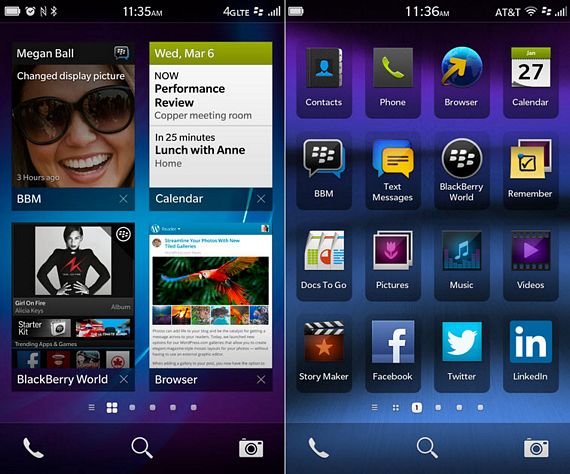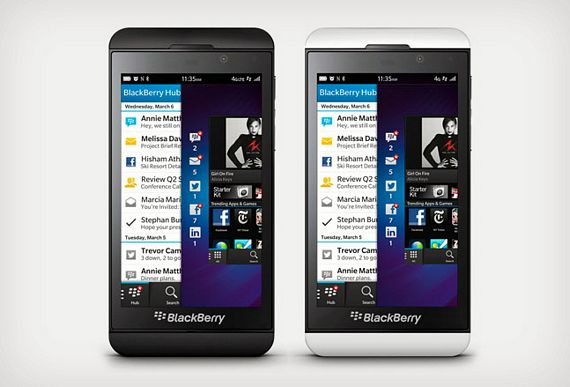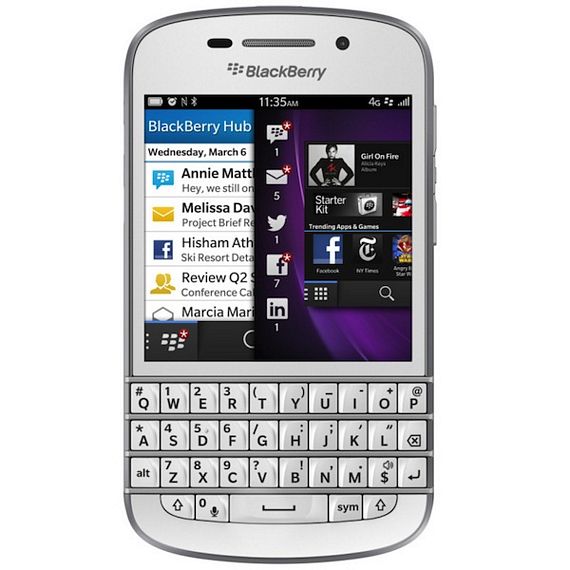RIM is dead. Well, sort of. Yesterday, the company announced they’re ditching the Research in Motion moniker in favor of their globally-popular brand BlackBerry. Yep, the company that makes BlackBerry phones is now known as BlackBerry — a sensible change, by the way, considering how little-known the RIM name is outside of North America.
More importantly, the renamed company has announced a new platform, BlackBerry 10 OS, and two new phones, the BlackBerry Z10 and the BlackBerry Q10. Will this mean a resurgence for the company that once ruled the mobile landscape? We’ll let you be the judge of that.
BlackBerry OS 10
Billed as a “fully redesigned and modern OS,” the new platform is a sort of clean-sheet approach for the company, likely bringing an entirely new experience to its shrinking army of users. All the familiar smartphone features other platforms have embraced are now onboard, all while managing to maintain a focus on productivity. While the Playbook showed us what could be for a refreshed BlackBerry phone, OS 10 brings those very ideas to life.
Chances are good that the new updates will more than satisfy the BlackBerry faithful. How well it can attract those who have migrated to other mobile platforms, though, will remain up in the air. Most notable of the additions to the new platform include:
- Gestures. Unlike previous generations, the OS 10 can work entirely independent of physical inputs, opting for on-screen gestures instead. That means, plenty of swiping, tapping, dragging and pinching — the same way other platforms have been doing the past couple of years.
- BlackBerry Balance. There was a time, before phones grew into the 4- and 5-inch behemoths they are, that some people kept two phones — one for personal and another for business. BlackBerry tries to provide the same convenience with Balance, which let you separate personal content from business content using features baked into the system. With the feature, a company’s IT department can easily wipe out all enterprise content when you leave for a different job — something not quite as easy to manage on other platforms.
- BlackBerry Hub. One of the best features of the OS, the Hub screen can be brought up, literally, from any app or feature with a single gesture (swipe up then right in one motion). It’s, pretty much, an aggregated list of events — SMS, emails, Twitter replies and DMs, Facebook messages, BBMs, missed calls, voicemails and other app notifications. Pros: It’s a great way to quickly check activity. Cons: It can turn into a crowded mess very quickly.
- Keyboard. For the first time, BlackBerry has managed to deliver a virtual QWERTY experience that’s actually good. More than the size, travel and responsiveness, though, the predictive feature is the one that manages to impress, offering suggestions from words and phrases that frequently appear in your email and social history, effectively speeding up your texting speed over time if you make use of it.
- Voice Recognition. Like with other mobile platforms, BlackBerry OS 10 now includes full voice recognition, allowing you to dictate messages and speak commands out loud. Despite being new to the platform, reports are that the voice features are actually quite sophisticated, managing to correctly parse even more complicated sentences.
- Camera. The camera app is pretty vanilla for smartphones. While it doesn’t quite add anything special to the table, it does bring BlackBerry up to par with the feature set found in modern smartphone platforms.
- BlackBerry Protect. An additional security feature, it gives you a straightforward way to find your phone in case you lose it for whatever reason, lock it wirelessly and, if all hope is lost, wipe its contents remotely.
- Apps. Stock apps cover most of what users will need — browser, BBM, Maps and so on. For the rest, BlackBerry World offers a good selection of software, along with a host of other content (music, video and all that). Many PlayBook apps can be run on the OS, too — just don’t expect them to render well on the smaller display (at least, in the short term, as developers get to working on the UI).
The new flagship BlackBerry has been in the rumor mill for many weeks, so those who religiously follow tech blogs won’t find anything about it much of a surprise. Shying away from the supersize trend for flagship devices, the BlackBerry Z10 sports a pocket-friendlier 4.2-inch display, sporting dimensions that total 5.13 x 2.6 x 0.37 inches and a weight of 4.86 oz.
While I don’t find the design particularly striking, it is attractive in its own right, with a shell combining a nice balance of aluminum and hard textured plastic. It’s slim at 0.37 inches, although far from the razor-thin frames of most premium devices in the market today.
Details of the Z10 include a 1,280 x 768 display resolution, an 8.0 megapixel rear camera, a 2.0 megapixel front-facing video cam, aGPS, LTE, Bluetooth 4.0, WiFi, NFC, MHL, 16GB of internal storage, microSD card expansion, and an 1800 mAh battery. Muscle is provided by a 1.5GHz dual-core processor and an Adreno 225 GPU, paired with 2GB of RAM.
Verizon has confirmed they’ll have the BlackBerry Z10 on their roster in March, priced at $199.99 on a new two-year agreement. No word yet on other carriers who might pick it up.
BlackBerry Q10
BlackBerry built their brand on QWERTY candybars, so it isn’t a surprise the second of their two new handsets, the BlackBerry Q10, bears that familiar design. After all, it isn’t exaggerating to say that a lot of people (especially BlackBerry diehards) who’ve grown weary with touchscreen typing are genuinely looking forward to modern smartphone features in the classic typing-friendly form factor.
Since it’s built to run BlackBerry 10 OS, the handset also comes with a touchscreen right above the physical keys. That way, you get all the benefits of BlackBerry’s vaunted tactile keyboard, all while enjoying all of the new platform’s gesture-based offerings.
Details of the BlackBerry Q10 include a 3.1-inch AMOLED touchscreen (720 x 720 resolution), a 35-key QWERTY panel, an 8.0 megapixel camera module in the rear (with 1080p video recording), a 2.0 megapixel video cam in front, a 1.5GHz dual-core processor, 2GB of RAM, aGPS, LTE, NFC, 16GB of onboard storage and microSD card expansion. Dimensions are 4.71 x 2.63 x 0.41 inches, with a weight of 4.9 ounces.
AT&T, Sprint, and Verizon have already confirmed plans to release the BlackBerry Q10. It’s expected to hit shelves sometime in April.



